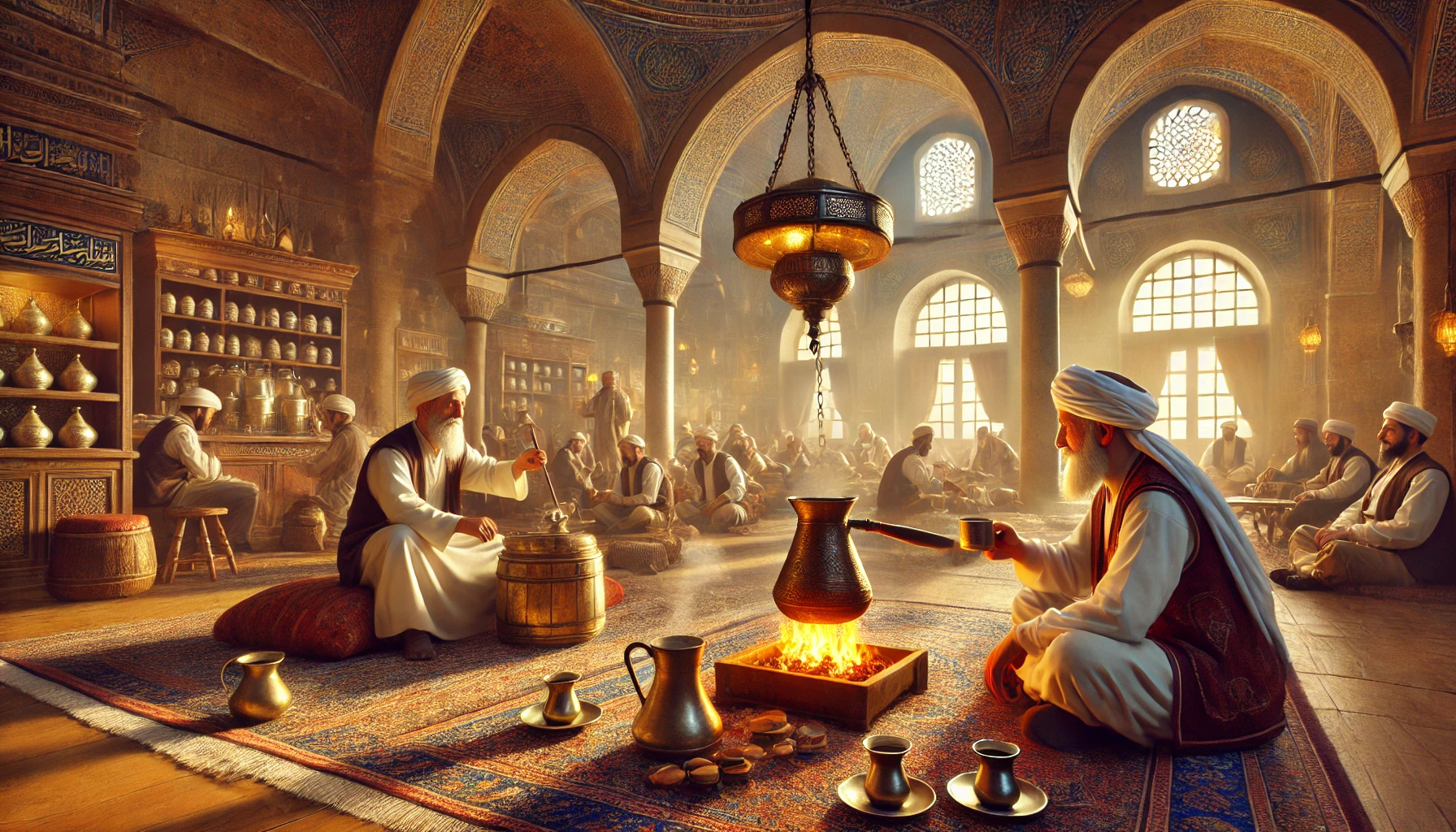Before coffee became a global commodity, before the rise of espresso machines and artisan baristas, it was an essential part of spiritual life, scholarship, and social transformation in the Islamic world. From the Sufi monasteries of Yemen to the bustling coffeehouses of Cairo and Istanbul, coffee played a pivotal role in reshaping how people gathered, worshipped, and exchanged ideas. This article explores how coffee didn’t just spread through the Islamic world—it transformed it.
A Sacred Start: Coffee’s Spiritual Roots in Yemen
While Ethiopia is considered the birthplace of the coffee plant, Yemen holds the title of being the first region to cultivate and brew coffee as a beverage with intention and purpose. During the 15th century, Sufi mystics in Yemen’s highlands began using coffee to aid in spiritual practices.
These mystics, known for their long hours of nighttime prayer and meditation (known as dhikr), found that coffee helped them stay awake and alert. It wasn’t just a stimulant—it was seen as a gift from God that allowed for deeper contemplation and connection with the divine.
The term used for coffee in Arabic, qahwa, originally referred to wine. As Islam forbade the consumption of alcohol, coffee became known as the “wine of Islam“—a beverage that energized without violating religious law.
The Rise of Mocha: Birthplace of Coffee Trade
The port city of Mocha, located on the Yemeni coast, became the first commercial hub for coffee. From here, coffee was exported throughout the Middle East and beyond. For centuries, Mocha controlled the global supply of coffee beans. The beans exported were typically boiled or roasted before shipping, preventing other nations from growing their own coffee crops and protecting Yemen’s monopoly.
Mocha’s influence was so powerful that to this day, the term “mocha” is associated with coffee, despite many people not knowing its historical origin.
Coffeehouses in Mecca: A Revolution in Social Gathering
Coffee’s popularity spread rapidly from Yemen to Mecca, a holy city of immense religious and cultural importance in the Islamic world. Here, coffee transcended its religious role and began infiltrating daily life. The first coffeehouses, or qahveh khaneh, began appearing—public spaces where people could gather to drink coffee, converse, play games, and listen to music or poetry.
These coffeehouses were unlike anything society had seen before. They quickly became hubs of social interaction, breaking traditional barriers between different social classes. Scholars, poets, merchants, and everyday citizens could all be found engaging in spirited debates or enjoying communal storytelling.
Controversy and Censorship: Religious Pushback
Despite its growing popularity, coffee was not universally accepted. Religious and political authorities began to grow uneasy with the powerful social influence of coffeehouses. The gatherings were lively, and often included discussions on politics, theology, and social issues—conversations that were difficult to control or monitor.
In 1511, the governor of Mecca, Khair Beg, banned coffee, fearing it encouraged sedition and immorality. He saw the social gatherings as threats to the religious order and public discipline. The ban, however, was short-lived. The Sultan of Cairo intervened and overturned the ruling, stating that coffee was not harmful and should not be prohibited.
Over the years, similar bans occurred in other cities such as Cairo and Constantinople (modern-day Istanbul), but none held for long. The people loved coffee too much—and by then, it had become ingrained in Islamic culture.
Cairo and Coffee’s Role in Education
In Cairo, coffee took on an even more intellectual role. The city’s religious schools and universities, particularly Al-Azhar University, became notable for students drinking coffee to help stay awake during long periods of study and prayer. Coffee was not just acceptable—it was encouraged among scholars, helping to reinforce its position as a tool of focus and discipline.
As coffeehouses opened in Cairo, they became closely associated with intellectualism, performance arts, and literature. They often hosted poetry readings, debates, and public recitations, making them cultural institutions in their own right.
The Ottoman Empire: Brewing Culture and Tradition
Coffee’s ascent into the heart of the Islamic world culminated with its adoption by the Ottoman Empire. In the mid-1500s, coffee reached Constantinople and quickly became a favorite of the ruling elite. The Ottomans not only drank coffee—they elevated it to an art form.
Specialized coffee brewing methods were developed, leading to the creation of what is now known as Turkish coffee. Finely ground beans were simmered (not boiled) in a small pot called a cezve, and served in small cups without milk. The Ottomans introduced specific etiquette and presentation rituals, turning coffee into a mark of refinement.
Within the Ottoman court, coffee was so significant that an official title existed: Chief Coffee Maker (kahvecibaşı), who prepared the Sultan’s personal coffee and was often trusted as a close confidant.
Coffeehouses in Istanbul: Political and Cultural Influence
By the late 16th century, Istanbul (then Constantinople) boasted dozens of coffeehouses, each known for a unique atmosphere—some catered to musicians, others to poets, and many to political dissidents. They were widely regarded as places where opinions were formed and revolutions were whispered.
The ruling authorities continued to fear the influence of coffeehouses. Under Sultan Murad IV in the 1600s, coffee was banned again, and violations were punished harshly. Still, the ban was eventually lifted, and coffeehouses returned, stronger than ever.
In Istanbul, coffeehouses weren’t just about drink—they were about identity, expression, and influence.
Coffee and Gender in the Islamic World
Though coffeehouses were predominantly male-dominated spaces, coffee itself was enjoyed by both men and women. Within homes, coffee ceremonies and traditions developed among women, particularly in the Ottoman harem and upper-class households. Serving coffee was seen as a form of hospitality and domestic refinement.
In Ottoman marriage traditions, a woman’s skill in making coffee was often considered during courtship. Coffee preparation was not just practical—it was symbolic of care, patience, and cultural pride.
Coffee and Pilgrimage: Mecca as a Gateway to the World
The Islamic Hajj pilgrimage played a significant role in coffee’s wider dissemination. As pilgrims traveled to Mecca from across the Islamic world, they encountered coffee and brought it back to their home regions—from North Africa to Central Asia.
These journeys helped transform coffee into a truly pan-Islamic phenomenon, integrating it into various languages, customs, and culinary traditions.
The Cultural Legacy of Islamic Coffee History
The Islamic world’s relationship with coffee laid the foundation for everything that came later. The rituals, debates, controversy, and innovation surrounding coffee in the Islamic world shaped its identity for centuries to come.
It gave the world:
- The first coffeehouses, precursors to modern cafés
- The association of coffee with intellect and conversation
- Brewing techniques still used today, like Turkish coffee
- A model for how coffee could be both sacred and social
These contributions remain visible in how coffee is enjoyed worldwide today.
What We Can Learn Today
Understanding how coffee conquered the Islamic world offers valuable insights into the power of community, resilience, and adaptation. Even when challenged by religious authorities or political bans, coffee found a way to flourish—because it met real human needs: connection, focus, and ritual.
As we sip our modern cappuccinos or cold brews, we’re not just enjoying a drink. We’re taking part in a global tradition that was shaped, protected, and celebrated by centuries of Islamic history.

